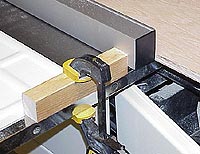This is a Veteran Owned site
| |
||
Stabilize Your Rip Fence
A simple way to defeat the forceText and photos by Tom Hintz One of the primary qualities woodworkers look for in a table saw is a rip fence that does not flex. The growing popularity of the t-square style fences that clamp on the front rail but only rest on the rear rail makes some of us wonder. Most, if not all of the modern fence systems supplied with table saws in the contractor and up range work very well when running normal width boards through them. With relatively narrow lumber, there is little opportunity to apply large amounts of force against the out feed end of the fence. Get on the outside of a 4 by 8 foot sheet of plywood and the amount of leverage available jumps substantially and the opportunity to inadvertently apply tremendous forces against the far end of the fence increases as well. If you notice even small variations in the width of ripped pieces of sheet goods, chances are you are leaning on your fence more than it can safely handle. A retired cabinetmaker with well over 30 years in a pro woodshop sent me an email on this subject. In part his email said, "We had all the best fences money could buy in our shop, and we had all of them blocked on the out feed end when cutting sheet stock. I don't care what fence you have, lean on a sheet of plywood a little too much and they all move." He went on to describe the "block" used in his shop and I present it here with his permission. The solution is surprisingly simple. They cut an 8-inch length of 2 x 2 stock, and glued (rubber cement) a piece of rubber to the bottom. The rubber piece was sacrificed by one of those rubber sheets you may have in a kitchen drawer for opening stubborn jars. Once the fence is locked at the proper setting, the block is placed so it is in light contact against the backside of the out feed end and clamped to the rail. Even I can do it, and will. Whether you think your fence is deflecting or not, this is a very simple and essentially free way to make certain your long rips through sheets of plywood come out straight the first time. If you know your fence has a flex problem, this is a simple way to combat it. Do you have a comment about this page? - Email Me! Back to the Tips & Tricks List
|
All written, photographic and drawn materials are property of and copyright by NewWoodworker.com LLC 2000-2019. Materials may not be used in any way without the written permission of the owner.

